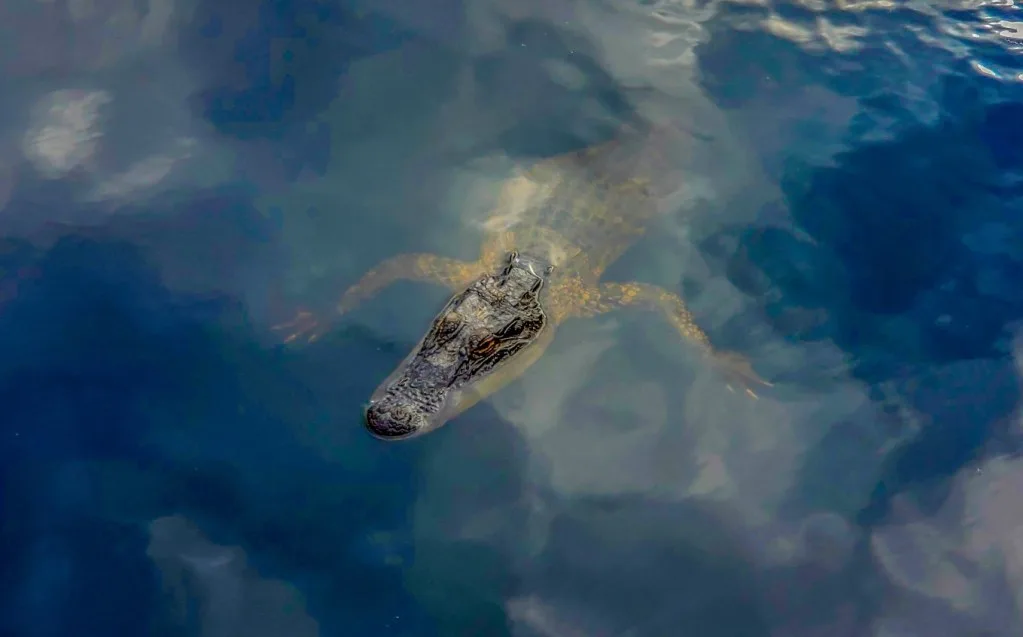Have you heard the stories about Lake Powell?
Some say there are alligators and sharks in the water.
Is it safe to swim there? Read on to find out the truth behind Lake Powell.
Let’s jump in!
About Lake Powell
The flooding of Glen Canyon is what created Lake Powell, an artificial reservoir in Arizona. The process began in the mid to late 50s when Merrit-Chapman & Scott constructed the Glen Canyon Dam.
On October 15, 1956, President Dwight D. Eisenhower pressed a button in DC and set off the explosions that began the construction of the dam.
In September 1963, the Colorado River began filling in Lake Powell. The lake didn’t fill up until June 1980! The dam is 710 feet high and cost $155 million to build.
The reservoir was created as water storage and only drained during times of drought. The water provides hydropower and recreation. The lake also helps fulfill city, industrial, and agricultural needs.
Today, Lake Powell is a popular vacation spot with two million visitors each year. The lake is the second-largest artificial reservoir in the USA, behind Lake Mead. Lake Powell’s water levels are in constant flux, reshaping Lake Powell’s 1960 miles of shore. Lake Powell has 96 significant canyons and a maximum depth of 561 feet at the dam.
In the 70s and 80s, Glen Canyon Dam became a hydroelectric power plant with the addition of turbines and generators. The dam is the second-highest concrete-arch dam in the USA, second to Hoover Dam.
Anyone wanting to learn more about the dam can visit the Carl B. Hayden Visitor Center. The visitor center is located 700 feet above the Colorado River and overlooks Glen Canyon Dam and Bridge. Once at the visitor center, you can also participate in a guided dam and power plant tour.

Where Is Lake Powell?
Although Lake Powell is only 13% of the Glen Canyon National Recreation Area, it steals the show with miles of sky blue waters. The red rocky cliff walls only add to the dramatic landscape and appeal of the lake.
The 186-mile long Lake Powell is part of the Colorado River in northern Arizona and stretches into southern Utah. Because the lake is large, the best way to get there is to decide what part of the lake you would like to visit. If you aren’t sure where to begin, we suggest starting at one of the five visitor centers.
If you’re in Arizona, you have three options. You can start at Carl Hayden Visitor Center or Glen Canyon Conservancy Flagship in Page. Your other option in Arizona is the Navajo Bridge Interpretive Center in Marble Canyon.
You might want to check out the Bullfrog Visitor Center or the Escalante Interagency Visitor Center if you’re in Utah.
Pro Tip: We compared which Lake Powell Campgrounds Are Decent, Better and The Best to help you decide where to stay at on your adventure.
What Kind of Creatures Live in Lake Powell?
Although Lake Powell is artificial, it’s home to various creatures. You might see bobcats, bighorn sheep, or coyotes on land. The area is home to 315 species of birds, including different kinds of owls, herons, eagles, and ducks.
But what lurks beneath the blue waters of Lake Powell? There are bass, catfish, bluegill, and walleye. What about alligators and sharks?
Alligators need to be able to sleep in mud tunnels to survive. They need access to fresh slow-moving waters in rivers and lakes. They also need food, and there are plenty of fish for alligators to eat in Lake Powell.
The only reference to alligators in the area comes from an article back in 2016. According to The Spectrum, the Public Information Officer at Glen Canyon found two alligators in the area. So is it true? This article was indeed published, but it’s from April 1!
Sharks typically need saltwater, but some can survive in freshwater. After scouring the internet for hours, we couldn’t find any evidence of sharks in Lake Powell. At least not the Lake Powell in Arizona/Utah.
However, authorities found a shark in Yuma Canal in Arizona. It was found dead in a freshwater irrigation canal. And no one knows how it got there.

Is It Safe to Swim in Lake Powell?
Many people go to Lake Powell and swim even though there are no lifeguards. The warm summer temperatures and beauty draw millions to visit each year. Just know the dangers and do your best to avoid them.
Most of Lake Powell’s shoreline is undeveloped, but the few beach-like areas, such as Lone Rock, fill up. These crowded beaches could mean water quality issues and contaminated shores. Quagga mussel shells line the beaches in the area and can cut up your or your pet’s feet.
The NPS notes that water quality changes occur during storms, varying water levels, algal blooms, and waste from people, wildlife, and livestock. They recommend washing up with soap, not drinking the water, and avoiding exposure to lake water if you have open sores and cuts.
Also, avoid areas with algal scum floating on the water, as it poses health risks. Do not swim or even ski or boat near it since it can become airborne.

Things To Do Near Lake Powell
If you have had your fill of swimming and boating, or it’s not your thing, there are plenty of things to do on land.
Glen Canyon Dam
We already mentioned Glen Canyon Dam, but it might be a great place to explore. If it weren’t for the dam, Lake Powell wouldn’t even exist. If you visit the dam, you can learn more about Lake Powell and its creation. You can opt for a guided tour or just enjoy the informative displays at the Carl B. Hayden Visitor Center.
Antelope Canyon
Suppose you want to try something different than Lake Powell but just as breathtaking. You might want to check out Antelope Canyon. It’s is run by the Navajo Nation Parks and Recreation. You can explore via guided tour and visit some of the “instafamous” areas inside the canyon.
Pro Tip: Check out our ultimate Antelope Canyon Road Trip Guide before heading out to Lake Powell.
Horseshoe Bend
Another popular place in the area is Horseshoe Bend. It’s around five miles from Carl Hayden Visitor Center. You can hike the 1.5-mile round-trip from the Horsehoe Bend parking lot to an overlook. Make sure to research hours and fees before heading out.
Lake Powell is Cool, With or Without Alligators and Sharks
Although there is no proof of alligators or sharks in Lake Powell, the lake is still a fantastic place. It’s beautiful, helps residents, and provides outdoor recreation. And, of course, it’s an engineering feat.
Have you visited Lake Powell? What do you think of the area? Let us know in the comments.
Discover the Best Free Camping Across the USA
To be honest with you, we hate paying for camping. There are so many free campsites in America (with complete privacy).
You should give it a try!
As a matter of fact, these free campsites are yours. Every time you pay federal taxes, you’re contributing to these lands.
Become a FREE CAMPING INSIDER and join the 100,000 campers who love to score the best site!
We’ll send you the 50 Best Free Campsites in the USA (one per state). Access the list by submitting your email below: